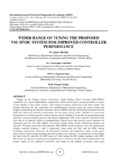Wider range of tuning the proposed VSC-HVDC system for improved controller performance

View/
Date
2016Author
Muriuki, J.
Muriithi, Christopher M.
Ngoo, L.
Nyakoe, G.N.
Metadata
Show full item recordAbstract
Tuning of the Voltage Source Converters, High Voltage Direct Current (VSC-HVDC)
controllers is a critical undertaking continuously carried out in power system operation to ensure system stability is kept under control while making maximum utilization of the plant output. The transfer functions for the controllers are mathematically derived using the control loops and properly tuned using the modulus optimum criterion (MOC) and the symmetrical optimum criterion (SOC) for improved controller performance. In this study, tuning of the controllers is carried out through the act of balancing the system response and its stability by selecting the proportional gain and time constant carefully based on the desired application. The vector control is utilized in this work due to its inherent ability to independently control active and reactive power between the converters and the grid. The stability of a power system relies on the symmetrical distance (a) selected. Previous researches advocated for VSC-HVDC control system to have the symmetrical distance selected between 2 and 4 respectively when using the SOC and the MOC tuning techniques respectively. However, the theoretical analysis and simulation results in this paper shows that for quick system response time and stability, the value of 'a' is selected as 8 when tuning the inner current controller by MOC and a=2 while tuning the DC voltage regulator with SOC. The model developed is implemented in Dig Silent Power Factory and the results indicate that with proper tuning of the proposed controllers and based on the method of tuning, some good
